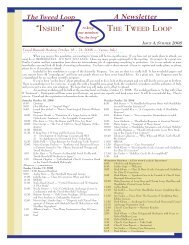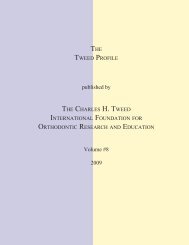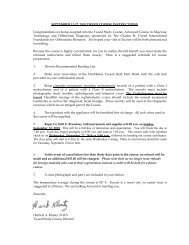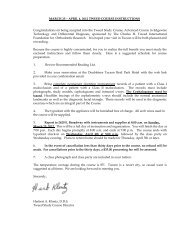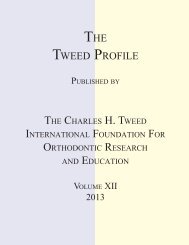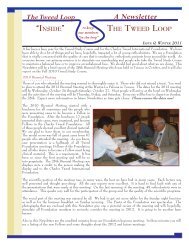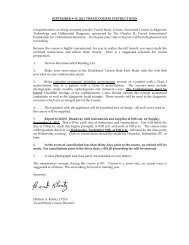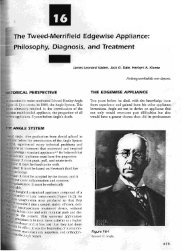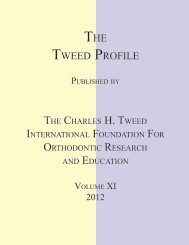© 2006 - The Charles H. Tweed International Foundation
© 2006 - The Charles H. Tweed International Foundation
© 2006 - The Charles H. Tweed International Foundation
You also want an ePaper? Increase the reach of your titles
YUMPU automatically turns print PDFs into web optimized ePapers that Google loves.
Fig. 5. B, Tracings: extraction of maxillary first premolars and mandibularsecond premolars (pretreatment-left; posttreatment-right).nonextraction group finished treatment with a Z-angle 8.12° greaterand an E-value 2.59 mm more negative than did the four firstpremolar extraction subgroup.CONCLUSIONS1. Both the extraction and nonextraction group facial profileFig. 5. A, Facial photographs: extraction of maxillaryfirst premolars and mandibular second premo-treatment.value averages were within the normal range at the completion oflars (pretreatment-left; posttreatment-right). 2. <strong>The</strong> average posttreatment lip profile position of thenonextraction group was slightly more retrusive than that of the extraction group.3. <strong>The</strong> extraction group had greater pretreatment facial imbalances.4. <strong>The</strong> extraction group had the greatest improvement in facial balance.5. In all patients in the extraction group, the common denominator “chin prominence” either remained in balance or wasimproved.6. <strong>The</strong> smiles in both groups were balanced and pleasing except for a few patients who had vertical skeletaldisharmonies.7. With a sound diagnostic scheme, treatment plan, and management of extraction space, extraction of the proper teethcan create balanced facial esthetics, not destroy it.Evaluation of facial profiles and facial balance is a constant, continuous, lifelong study and learning process fororthodontists. Tooth movement and proper positioning of the teeth to ensure favorable facial changes and to avoidunfavorable changes should be in the orthodontist’s “diagnostic” mind from the very first examination. To treat patientsnonextraction for the sake of not removing teeth, ease of treatment, or the dictates of an appliance is not sound reasoningand makes as much diagnostic sense as treating all patients with the extraction of all four first premolars. In other23



